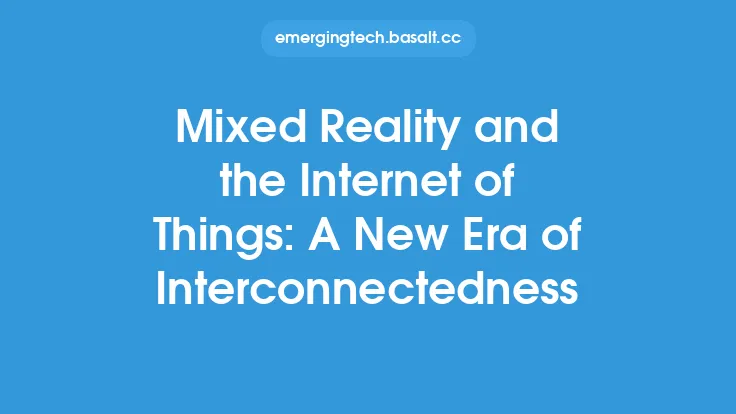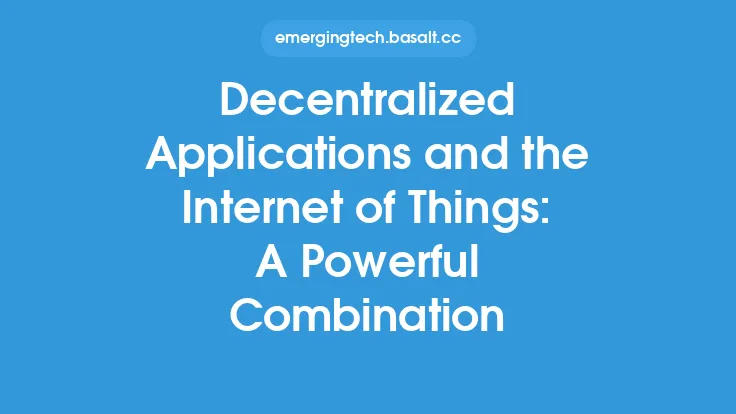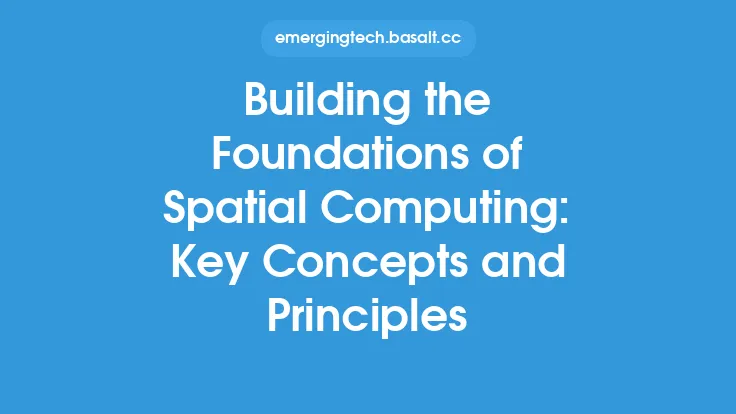The concept of spatial computing has been gaining significant attention in recent years, particularly with the rise of the Internet of Things (IoT). Spatial computing refers to the ability of computers to understand and interact with their physical environment, using a combination of sensors, cameras, and other technologies to perceive and interpret spatial information. This technology has the potential to revolutionize the way we interact with the world around us, enabling a new era of interconnectedness between devices, people, and the physical environment.
Introduction to Spatial Computing and IoT
Spatial computing and IoT are closely related concepts, as they both involve the use of sensors and other technologies to collect and analyze data from the physical environment. IoT refers to the network of physical devices, vehicles, home appliances, and other items that are embedded with sensors, software, and connectivity, allowing them to collect and exchange data. Spatial computing takes this concept a step further, using the data collected from IoT devices to create a digital representation of the physical environment, and enabling computers to interact with and understand this environment in a more intuitive way.
Key Technologies Enabling Spatial Computing and IoT
Several key technologies are enabling the development of spatial computing and IoT, including computer vision, machine learning, and sensor technologies. Computer vision refers to the ability of computers to interpret and understand visual data from cameras and other sensors, while machine learning enables computers to learn from this data and make predictions or take actions. Sensor technologies, such as GPS, accelerometers, and gyroscopes, provide the data that computers need to understand their physical environment. Other technologies, such as Wi-Fi, Bluetooth, and cellular networks, enable devices to communicate with each other and with the cloud, facilitating the exchange of data and enabling the creation of a seamless and interconnected experience.
Applications of Spatial Computing and IoT
The applications of spatial computing and IoT are numerous and varied, ranging from smart homes and cities to industrial automation and healthcare. In the context of smart homes, spatial computing and IoT can be used to create a seamless and intuitive experience, enabling users to control lighting, temperature, and security systems with ease. In industrial automation, spatial computing and IoT can be used to optimize production processes, predict maintenance needs, and improve product quality. In healthcare, spatial computing and IoT can be used to monitor patient health, track medical equipment, and optimize clinical workflows.
Technical Requirements for Spatial Computing and IoT
The technical requirements for spatial computing and IoT are significant, requiring the integration of multiple technologies and systems. Devices must be equipped with sensors, software, and connectivity, and must be able to communicate with each other and with the cloud. Data must be collected, analyzed, and interpreted in real-time, using machine learning and other advanced analytics techniques. Security and privacy must also be ensured, using encryption, authentication, and other technologies to protect data and prevent unauthorized access.
Challenges and Limitations of Spatial Computing and IoT
Despite the many benefits of spatial computing and IoT, there are also several challenges and limitations that must be addressed. One of the main challenges is the need for standardization, as different devices and systems may use different protocols and technologies, making it difficult to achieve seamless communication and interoperability. Another challenge is the need for security and privacy, as the collection and analysis of spatial data raises significant concerns about data protection and user privacy. Additionally, the complexity of spatial computing and IoT systems can make them difficult to design, deploy, and maintain, requiring significant expertise and resources.
Future Directions for Spatial Computing and IoT
The future of spatial computing and IoT is exciting and rapidly evolving, with new technologies and applications emerging all the time. One of the key trends is the increasing use of artificial intelligence and machine learning, enabling devices and systems to learn from data and make predictions or take actions. Another trend is the growing importance of edge computing, which enables data to be processed and analyzed in real-time, at the edge of the network, rather than in the cloud. Additionally, the development of new sensor technologies, such as lidar and radar, is enabling the creation of more accurate and detailed digital models of the physical environment, and facilitating the development of new applications and use cases.
Conclusion
In conclusion, spatial computing and IoT are closely related concepts that have the potential to revolutionize the way we interact with the world around us. By enabling computers to understand and interact with their physical environment, spatial computing and IoT are creating a new era of interconnectedness between devices, people, and the physical environment. While there are several challenges and limitations that must be addressed, the benefits of spatial computing and IoT are significant, ranging from improved efficiency and productivity to enhanced safety and convenience. As the technology continues to evolve, we can expect to see new and innovative applications emerge, transforming industries and revolutionizing the way we live and work.





